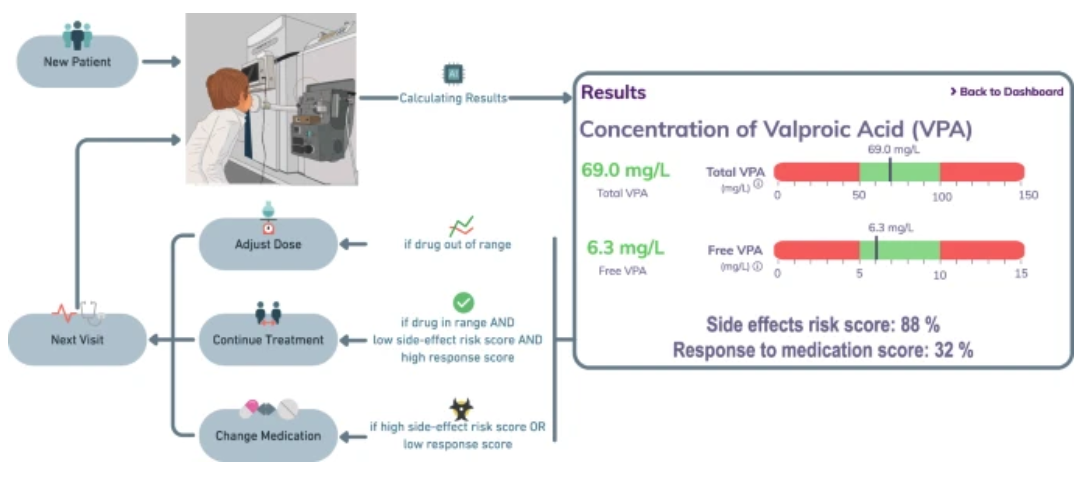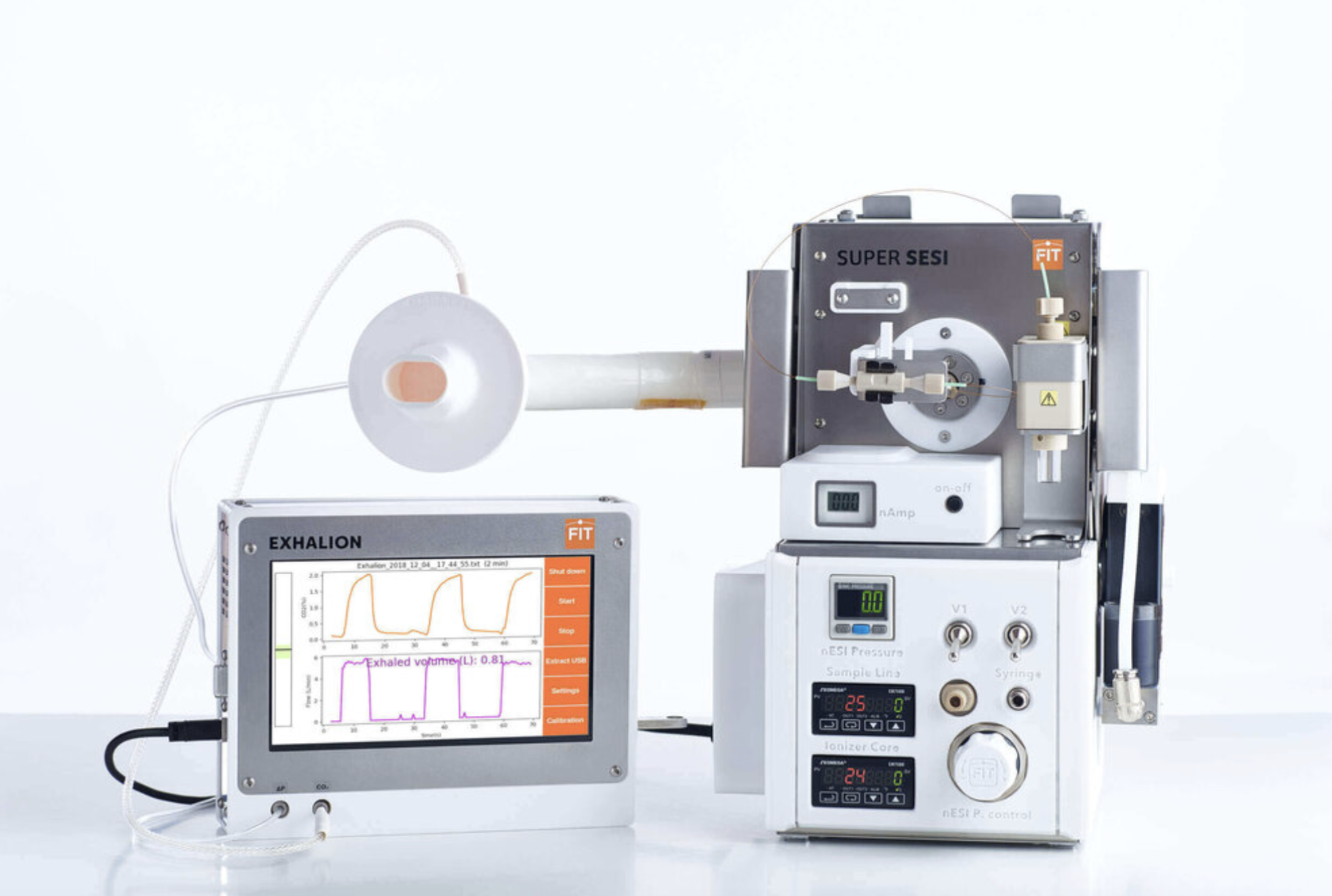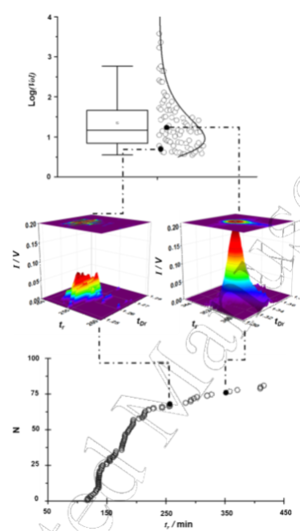Personalised therapeutic management of epileptic patients guided by pathway-driven breath metabolomics
Kapil Dev Singh, Martin Osswald, Victoria C. Ziesenitz, Mo Awchi, Jakob Usemann, Lukas L. Imbach, Malcolm Kohler, Diego García-Gómez, Johannes van den Anker, Urs Frey, Alexandre N. Datta & Pablo Sinues
Therapeutic management of epilepsy remains a challenge, since optimal systemic antiseizure medication (ASM) concentrations do not always correlate with improved clinical outcome and minimal side effects. We tested the feasibility of noninvasive real-time breath metabolomics as an extension of traditional therapeutic drug monitoring for patient stratification by simultaneously monitoring drug-related and drug-modulated metabolites.
Quantification of volatile organic compounds by secondary electrospray ionization-high resolution mass spectrometry
Chao Liu, Jiafa Zeng, Pablo Sinues, Mingliang Fang, Zhen Zhou, Xue Li.
SESI-HRMS has been successfully applied in multiple applications, including breath analysis, animals and plants VOCs emissions, analysis of headspace of cell cultures and indoor and outdoor air. In this study we aim to develop a quantitative method for eight representative VOCs, including ketones (acetone, 2-butanone and 2-pentanone), alkenes (isoprene and α-terpinene) and aromatics (toluene, styrene and mesitylene).
Real-time (on-line) chemical characterisation of thermal aerosols by super secondary electrospray ionization coupled with high-resolution mass spectrometry (Super SESI-HRMS)
T. Živković Semren, S. Majeed, M. Fatarova, C. Laszlo, C. Pak, S. Steiner, A. Kuczaj, A. Mazurov, M. Peitsch, N. Ivanov, J. Hoeng, and P. A. Guy
We used a programmable dual syringe pump (PDSP) connected to a super secondary electrospray ionisation (SESI) system interfaced with a Q Exactive HF mass spectrometer (MS) to detect the main constituents of thermally generated aerosols in real time. The benefits of Super SESI–HRMS for detecting drug aerosolisation from variably prepared in-house formulations with anatabine, azithromycin, chloroquine, favipiravir, and hydroxychloroquine were evaluated.
In vivo monitoring of volatile metabolic trajectories enables rapid diagnosis of influenza A infection
Zhihong Yin, Wenbo Huang, Kapil Dev Singh, Zhaoming Chen, Xing Chen, Zhen Zhou, Zifeng Yang, Pablo Sinues and Xue Li
We report that influenza A virus infection induces changes in odor traits that could be captured by real-time high-resolution mass spectrometry in a living mouse model. The most striking changes in the volatile metabolites may be associated mostly to glyoxylate/dicarboxylate metabolism.
Validation of breath biomarkers for obstructive sleep apnea
Nora Nowak, Anna Engler, Sira Thiel, Anna S. Stöberl, Pablo Sinues, Renato Zenobi, Malcolm Kohler
Here, we could confirm significant differences between metabolic patterns in exhaled breath from OSA patients compared to control subjects without OSA as well as the association of breath biomarker levels with disease severity. Our prediction of the diagnosis for the patients from this completely independent validation study using a classification model trained on the data from the previous study resulted in an area under the receiver operating characteristic curve of 0.66, which is comparable to questionnaire-based OSA screenings.
Online Real-Time Monitoring of Exhaled Breath Particles Reveals Unnoticed Transport of Nonvolatile Drugs from Blood to Breath
Xing Chen, Keda Zhang, Zhihong Yin, Mingliang Fang, Weidan Pu, Zhening Liu, Lei Li, Pablo Sinues, Robert Dallmann, Zhen Zhou and Xue Li
This study advances our knowledge on the mechanism by which nonvolatile drugs are transferred from blood into exhaled breath, providing guidance for breath test-based therapeutic drug monitoring.
Minimizing ion competition boosts volatile metabolome analysis by secondary electrospray ionization orbitrap mass spectrometry
Jiayi Lan, Jérôme Kaeslin, Giorgia Greter, Renato Zenobi
Here, we show that besides ion suppression, ion competition in the C-trap of Orbitrap instruments is another important factor that influences sensitivity and reproducibility of SESI-MS. Instead of acquiring the full mass-to-charge ratio (m/z) range, acquisition of consecutive m/z windows to minimize the ion competition effect allows the detection of more features.
Insights on the Working Principles of Secondary ElectrosprayIonization High‑Resolution Mass Spectrometry for QuantitativeAnalysis of Aerosol Chemical Composition
Xin Xu, · Jia Fa Zeng, · Dan Dan Jin,· Zheng Xu Huang, · Lei Li,·Anthony S. Wexler, · Man Nin Chan, ·Zhen Zhou, · Yong Jie Li and Xue Li
we demonstrated the working principles of secondary nanoelectrospray ionization (Sec-nESI) for real-time measurement of laboratory-generated organic aerosols using l-tartaric acid (TA) as a model compound. Factors affecting the detection of TA particles using a homemade Sec-nESI source coupled with a high-resolution mass spectrometer are systematically investigated.
Analyses of short-chain fatty acids and exhaled breath volatiles in dietary intervention trials for metabolic diseases
Jisun HJ Lee, Jiangjiang Zhu
The analysis of exhaled breath (breathomics) has gained attention as a useful technique to measure the human VOC profile altered as a result of dietary interventions. In this mini-review, we examined recent clinical trials that performed promising dietary interventions, SCFAs analysis in plasma/feces, and VOC profile analysis in exhaling breath to understand the relationship between dietary intervention and metabolic health.
Circadian Metabolomics from Breath
Steven A. Brown, Pablo Sinues
Metabolites like melatonin are essential in determining circadian phase. In the recent years, comprehensive metabolome analyses have unveiled entire panels of small biomolecules fluctuating in a circadian fashion, thus enabling a more precise determination of inner time and understanding of how circadian clock operates at the molecular level. Emerging analytical techniques allowing for the determination of exhaled metabolites in breath show promise to gain further insights noninvasively and in vivo into circadian metabolism.
Volatile organic compound breath signatures of children with cystic fibrosis by real-time SESI-HRMS
Ronja Weber, Naemi Haas, Astghik Baghdasaryan, Tobias Bruderer, Demet Inci, Srdjan Micic, Nathan Perkins, Renate Spinas, Renato Zenobi, Alexander Moeller
Early pulmonary infection and inflammation result in irreversible lung damage and are major contributors to cystic fibrosis (CF)-related morbidity. An easy to apply and noninvasive assessment for the timely detection of disease-associated complications would be of high value. We aimed to detect volatile organic compound (VOC) breath signatures of children with CF by real-time secondary electrospray ionisation high-resolution mass spectrometry (SESI-HRMS).
A total of 101 children, aged 4–18 years (CF=52; healthy controls=49) and comparable for sex, body mass index and lung function were included in this prospective cross-sectional study. Exhaled air was analysed by a SESI-source linked to a high-resolution time-of-flight mass spectrometer. Mass spectra ranging from m/z 50 to 500 were recorded.
Out of 3468 m/z features, 171 were significantly different in children with CF (false discovery rate adjusted p-value of 0.05). The predictive ability (CF versus healthy) was assessed by using a support-vector machine classifier and showed an average accuracy (repeated cross-validation) of 72.1% (sensitivity of 77.2% and specificity of 67.7%).
This is the first study to assess entire breath profiles of children with SESI-HRMS and to extract sets of VOCs that are associated with CF. We have detected a large set of exhaled molecules that are potentially related to CF, indicating that the molecular breath of children with CF is diverse and informative.
Identification of disease-specific molecular breath profiles in patients with allergic asthma
Ronja Weber, Srdjan Micic, Bettina Streckenbach, Lara Welti, Tobias Bruderer, Nathan Perkins, Demet Inci, Jakob Usemann, Alexander Möller
The diagnosis of asthma in children is still a clinical challenge. Breath-analysis has the potential to overcome this challenge. Our goal is to show that secondary electrospray ionization high-resolution mass-spectrometry (SESI-HRMS) can be used to detect asthma-specific metabolites in exhaled breath.
We are conducting an exploratory observational study comparing the molecular composition of exhaled breath from school children (5-18 years) with allergic asthma (confirmed by objective tests) to healthy controls. Patients are taken off their asthma medication two weeks prior to breath measurements. Breath analysis is performed on an AB SCIEX TripleTOF 5600+ HRMS coupled to a Super SESI ion source, detecting m/z features between 50 and 500 Da (mass accuracy <1ppm). A combination of data extraction and machine learning models is used to isolate the most discriminative features and assess the predictive power of breath profiles.
We acquired data from 47 children (21 with allergic asthma, 26 healthy controls). In our preliminary data analysis, we identified 193 m/z features which differed significantly between the two groups (adjusted p value < 0.05), which showed an average predictive power (asthma vs. healthy) of 78.7% (leave-one-out cross-validation with Random Forests algorithm). We could allocate molecular formulas to most significant m/z peaks. Compound identification is currently ongoing but some of the compounds have previously been reported in a biological context.
For the first time we identified exhaled molecules that differ between children with allergic asthma and healthy controls by real-time SESI-HRMS. Such a discovery has the potential to improve the early diagnosis of asthma.
Optimizing Secondary Electrospray Ionization High-Resolution Mass Spectrometry (SESI-HRMS) for the Analysis of Volatile Fatty Acids from Gut Microbiome
Jisun H. J. Lee and Jiangjiang Zhu
Gut microbiota plays essential roles in maintaining gut homeostasis. The composition of gut microbes and their metabolites are altered in response to diet and remedial agents such as antibiotics. However, little is known about the effect of antibiotics on the gut microbiota and their volatile metabolites. In this study, we evaluated the impact of a moderate level of ampicillin treatment on volatile fatty acids (VFAs) of gut microbial cultures using an optimized real-time secondary electrospray ionization coupled with high-resolution mass spectrometry (SESI-HRMS).
Bridging Targeted and Untargeted Mass Spectrometry-Based Metabolomics via Hybrid Approaches
Li Chen, Fanyi Zhong and Jiangjiang Zhu
This mini-review aims to discuss the development and applications of mass spectrometry (MS)-based hybrid approaches in metabolomics.
Detection of VOCs with Secondary Electrospray Ionization and Proton Transfer Reaction High-Resolution Mass Spec.: A Feature Comparison
Tobias Bruderer, Martin Thomas Gaugg, Luca Cappellin, Felipe Lopez-Hilfiker, Manuel A. Hutterli, Nathan Perkins, Renato Zenobi, and Alexander Moeller.
The analysis of volatiles is of high relevance for a wide range of applications from environmental air sampling, security screening to potential medical applications.
Real-time breath analysis of exhaled compounds upon peppermint oil ingestion by secondary electrospray ionization-high resolution mass spectrometry: technical aspects
Amanda Gisler, Jiayi Lan, Kapil Dev Singh Jakob Usemann, Urs Frey, Renato Zenobi and Pablo Sinues.
Breath analysis by secondary electrospray ionization high-resolution mass spectrometry (SESI-HRMS) has potential for clinical diagnosis and drug monitoring…
A benchmarking protocol for breath analysis: the peppermint experiment
Mr Ben Henderson, Dr Dorota M Ruszkiewicz, Mr Maxim Wilkinson, Dr Jonathan D Beauchamp, Dr Simona M Cristescu, Dr Stephen J Fowler, Dr Dahlia Salman, Dr Fabio Di Francesco, Dr Gudrun Koppen, Dr Jens Langejuergen, Dr Olaf Holz, Miss Andria Hadjithekli, Mr Sergi Moreno, Dr Michele Pedrotti, Professor Dr Pablo Sinues, Miss Gitte Slingers, Dr Michael Wilde, Dr Tommaso Lomonaco, Miss Delphine Zanella, Professor Renato Zenobi, Mr Joan Francis Focant, Dr Stanislas Grassin-Delyle, Dr Flavio Antonio Antonio Franchina, Miss Michaela Malásková, Dr Pierre-Hugues Stefanuto, Mr Giovanni Pugliese, Professor Dr Chris A Mayhew and Professor C. L. Paul Thomas.
Monitoring peppermint washout in the breath metabolome by secondary electrospray ionization-high resolution mass spectrometry
Jiayi Lan, Amanda Gisler, Tobias Bruderer, Pablo Sinues, Renato Zenobi.
In this study, a secondary electrospray ionization-high resolution mass spectrometer (SESI-HRMS) system was employed to profile the real-time exhaled metabolome of ten subjects who had ingested a peppermint oil capsule.
Breathborne Biomarkers and the Human Volatilome - 2nd Edition
Breathborne biomarkers carry information on the state of human health, and their role in aiding clinical diagnosis or in therapeutic monitoring has become increasingly important as advances in the field are made. Breathborne Biomarkers and the Human Volatilome, Second Edition, provides a comprehensive update and reworking of the 2013 book Volatile Biomarkers, by Anton Amann and David Smith. The new editing team has expanded this edition beyond volatile organic compounds to cover the broad field of breath analysis, including the many exciting developments that have occurred since the first edition was published. This thoroughly revised volume includes the latest discoveries and applications in breath research from the world's foremost scientists, and offers insights into related future developments. It is an ideal resource for researchers, scientists, and clinicians with an interest in breath analysis.
Evolution of indoor cooking emissions captured by using secondary electrospray ionization high resolution mass spectrometry
Jiafa Zeng, Zhujun Yu, Majda Mekic, Jiangping Liu, Sheng Li, Gwendal Loisel, Wei Gao, Adrien Gandolfo, Zhen Zhou, Xinming Wang, Hartmut Herrmann, Sasho Gligorovski, and Xue Li.
Cooking emissions represent a major source of air pollution in the indoor environment and exhibit adverse health effects caused by particulate matter together with volatile organic compounds (VOCs).




















